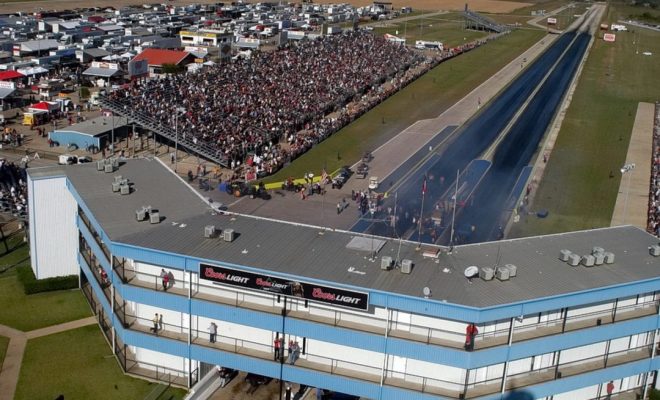TEXAS MOTORPLEX SET THE STANDARD FOR FUTURE DRAG STRIPS BACK IN 1986
 When you look at almost every new drag strip built in the 1990s and later, almost all of them have a bit of Texas Motorplex inspiration.
When you look at almost every new drag strip built in the 1990s and later, almost all of them have a bit of Texas Motorplex inspiration.
That's how far ahead of the game Billy Meyer's vision was when the track opened in 1986. Take a look at the NHRA Camping World Drag Racing Series roster of national event tracks, and it's not hard to see a bit of the Ennis, Texas-based facility.
Maybe, it's the wrap-around towers. You'll see them in Houston, Gainesville, Richmond, Topeka, Denver, and St. Louis. Even though Pomona isn't a drive-under, it's still basically the same design.
Or, could it be the entire concrete drag strip? There are five of those on the tour.
As Meyer sees it, imitation is the greatest form of flattery.
"Everybody did since '86, whether it's Houston or Englishtown," Meyer recalled. "Anybody did. When I say they used it, they basically duplicated the tower. Atlanta and all those different places, they tried to make them as similar. Some of them didn't have the ability to have the drive-through, but the ones that did basically just copied it, which is cool. Because it's a great layout. It works really good."
Probably the most interesting of the duplications came from Houston Raceway Park [HRP] in 1988. At the time, Meyer had purchased the IHRA and had brought the Texas Motorplex with him to his new venue. HRP was a political statement in response to Meyer's departure with the Texas Motorplex.
HRP lived up to the hype as a super track but missed out on probably the most significant milestone bragging point in 1988. Months before the first NHRA four-second Top Fuel run, Texan Eddie Hill secured the momentous run with a 4.99 pass in April 1988.
Maybe it was Don Prudhomme, one of the honored legends at this weekend's NHRA Fall Nationals, who said it best.
"From the time we pulled into the track here, we knew that drag racing was going to change completely because this track is going to make all the rest of them stand up and take notice of what a drag strip is supposed to be like and how it's supposed to be built," Prudhomme said. "And Billy Meyer did it."







































